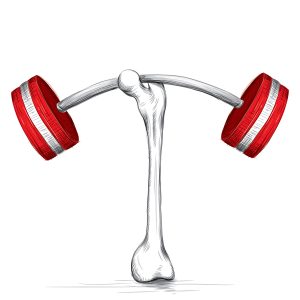While it is one of the most common conditions in Australia, Osteoporosis is often not well understood, even by those who are suffering from it. It currently affects 1 in 3 women and 1 in 4 men over 65 and currently costs almost 3.5 billion dollars every year. Even with a steady presence about it in the media, numbers are still on the rise.
Calcium and Osteoporosis
When you ask many people what the cause of Osteoporosis is, they will often say a lack of Calcium. Although this is not incorrect, it is not the full answer and this is where a greater understanding would help. Osteoporosis is actually a loss of bone mineral density, relative to the normal for your age. The calcium is an important part of the bone mineral density, but it is less than 60% of the make up of the bone.
What else makes up the bone density?
The bone matrix
Firstly and most importantly is the bone matrix. Think of it like the scaffolding structure inside the bone. The calcium then binds to the matrix to provide it with rigidity. The bone matrix is made up of Collagen fibres (yes, similar to those women have injected into their lips), which are built from protein. Without a good bone matrix structure, the calcium has nothing to bind to and the bone will not be able to maintain it’s strength and density.
Water
Secondly is water, which makes up to 10-20% percent of the bone and is critical for transporting minerals into the bone to keep it healthy.
Minerals
Calcium is one of a number of minerals which are important to maintaining good bone health. One is phosphorous, which is a large component of the bone mineral complex, second to calcium. Others like Manganesium, Zinc, Boron, Copper, Maganese, Potassium and Silica are also required, though not to the same extent.
What happens to bones in Osteoporosis?
Having a good balanced diet and a good water intake are obviously key factors in preventing and managing Osteoporosis, but they are not the only factor. Bone is also a dynamic structure, it is is constantly being broken down and rebuilt. This is critical to keeping the bone strong and healthy. What occurs in the bone in Osteoporosis, is more bone is being broken down than being rebuilt. Over time, this leads to the bone becoming weaker and more frail and fractures occurring. With ageing we do see a natural decline in the amount of bone being built, hence you being compared against people of your own age for testing for bone density. When it is significantly more than what is considered normal, then it classed as Osteoporosis.
How do we make our bones stronger?
One of the most effective ways to increase the amount of bone being built is resistance exercise. What this means is pushing, pulling or lifting movements beyond what you would normally do in day to day life. When the stress of these movements is placed on the bone, the body reacts by laying down more bone to make them stronger. This doesn’t happen quickly, in most cases 12 months is required to see positive improvements for the bone density. Once the bone strength and density is regained, exercises are needed to maintain it, though not at the same intensity needed to increase it. For those with Osteoporosis, who are looking at a strength program, it is recommended to seek professional advice. An Exercise Physiologist is the best person to discuss your concerns with and get them to design a program, which is suited to your needs. Exercise, when done safely and appropriately, can be one of the best approaches to reducing the effects of Osteoporosis.
Osteocise
To help promote this further, Osteoporosis Australia have begun promoting their Osteocise program, which is an exercise program designed to improve bone strength. It is being done at a small number of places around NSW. Please click here to find out more information.
Look at the big picture with Osteoporosis
In regards to Calcium intake, there is a plethora of information about it in the media, however I feel we need to not see it as the whole solution, but rather part of it for us to reverse the trend of Osteoporosis and having people living long, healthy and happy lives.


Thank you for sharing the right knowledge regarding osteoporosis. It is necessary to provide calcium to the bones and keeping bone mineral density in condition. For a healthy life, bones are the vital parts as they hold our entire body in a shape and without their support, nothing much can happen. Great to learn about Osteocise. Thank you for sharing the knowledge.